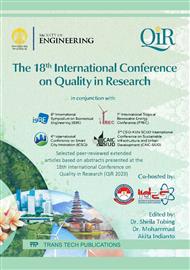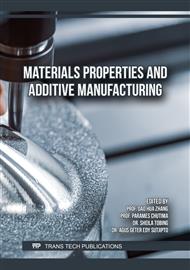p.3
p.9
p.21
p.29
p.41
p.53
p.63
p.71
The Effect of Cetyl Trimethylammonium Bromide Addition as Surfactant in Multiwalled Carbon Nanotube-Based Nanofluid for Quench Medium in Steel Heat Treatment Application
Abstract:
Nanoparticle addition into a fluid can increase the thermal conductivity. Such fluid is commonly called a nanofluid. Due to its improved heat transfer characteristic, nanofluid is widely used as coolant in engine or electronic equipment. In the steel heat treatment industry, nanofluid can be utilized as a quench medium. By controlling the amount of nanoparticle added in the nanofluid quench medium, the cooling rate can be adjusted. To preserve the heat transfer effectivity, the stability of the nanoparticle become very important. Hence, surfactant is quite essential to improve the particle stability and avoid particle agglomeration and sedimentation. In this study, a multiwalled carbon nanotube (MWCNT) was used as the nanoparticle in the distilled water. The concentration of the MWCNT was varied at 0.1, 0.3, and 0.5 % w/v. For the surfactant, Cetyl Trimethylammonium Bromide (CTAB) was chosen to disperse the particle better. In each of the three MWCNT variations, CTAB was added from 3 – 30% w/v. The maximum thermal conductivity obtained was in the nanofluid with 0.3% MWCNT and 5% CTAB at 0.72 W/mK. For the steel hardness, the value was roughly stable at 33 – 35 HRC in the nanofluid with no CTAB and 3 – 5% CTAB addition. Excessive surfactant addition at 30% CTAB decrease the hardness significantly up to 17 HRC.
Info:
Periodical:
Pages:
21-28
Citation:
Online since:
February 2024
Authors:
Keywords:
Price:
Сopyright:
© 2024 Trans Tech Publications Ltd. All Rights Reserved
Share:
Citation:



